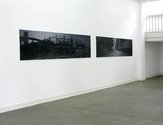John Hurrell – 17 February, 2010
They intrigue because of their hybrid technologies - imagine Laurence Aberhart combined with Andreas Gursky.
Auckland
Jin Jiangbo
Shanghai Ye! Shanghai
12 February - 20 March, 2010
With a population of over 20 million, Shanghai is the most enormous of Chinese cities, one of the largest metropolitan areas in the world. In 73 days it launches World Expo 2010, the largest event in China since the 2008 Olympics. Currently in Starkwhite the Chinese installation and multi-media artist Jin Jiangbo has presented a set of eight panoramic images of this city, the images the result of digitally enhanced, medium format, analogue photographs.
Since 2007 Jiangbo has been creating works like the series The Great Economic Retreat, which scoffed at the notion of China’s ‘economic miracle’ and examined the fragility of the labour market, notably the consequences of corporations moving their enterprises around in search of the cheapest labour source possible - and the devasting effect that has on the migrant labour supply. He recorded the architectural detritus left when such factories are abandoned.
Last year he came to New Zealand as a recipient of the Govtt-Brewster Art Gallery’s International Artist Residency Programme and made work for a New Plymouth show using the dilapidated freezing works and processing plant (now recently demolished) at Patea that closed in the early eighties as a consequence of Britain entering the EEC.
The Shanghai images at Starkwhite are a stark contrast to the hauntingly quiet Patea photographs of rural isolation. They are taken from much higher elevations and are more spectacular as outdoor vistas of urban chaos. These large (but not huge, as Jiangbo’s work can be) smokey blue-grey images, with their tightly controlled, muted colours, look like the results of some sort of camera obscura or ancient plate camera, with their softly darkening edges. They are a blend of fact with fiction. Despite their initial use of film, many are not strictly documentation - some elements are digitally repeated or distorted - though you might be easily fooled into not noticing that.
Packed with detail, Jiangbo’s delicately hued panoramas raise questions about a manic building programme that is being propelled along to reach the Expo deadline - ripping down whole suburbs to erect new architectural marvels for a potentially profitable, but temporary, fair. They examine the global recession and its consequences on the Chinese industrial landscape, critiquing the ruthless destruction implemented in the communist government’s pursuit of capitalist prosperity. Within these stunning panoramas the glories of contemporary architecture linger in the distance, while it is ruins and collapsed structures that we tend to scrutinise close-up.
What is interesting is that the Chinese government helped Jiangbo create these strangely moving images, assuming he would be glorifying the economic growth, and giving him easy access to construction sites and demolished city blocks, as well as remarkable vantage points like the tops of arched, steel-girdered bridges. It is a double game because contemporary art is now a highly profitable and respected industry in China.
Two vertical photographs by the Starkwhite office look at the Bund, the old part of Shanghai, now thoroughly modernised with colourful modernist buildings and towers on a bank of the Huangpo River.
The more common horizontal images are surprisingly varied. One has no people in it at all, another has distorted walls and tilted towers, while another still is almost perfectly symmetrical. They intrigue because of their hybrid technologies - imagine Laurence Aberhart combined with Andreas Gursky. Yet the result is an aura of romantic nostalgia mixed with an acerbic attack on economic ‘realism’.
Jiangbo is known primarily for his skill in multi-media. He has a reputation as a New Media wizard with an ability to create electronic spectacles to entertain large audiences, so this sort of show is quite modest - almost subdued - as a static, non-interactive display. It is immensely subtle work, chromatically and philosophically, requiring careful looking. It’s sensational, but quiet and dignified.
Thank you Starkwhite and the artist for the images.






 Advertising in this column
Advertising in this column Two Rooms presents a program of residencies and projects
Two Rooms presents a program of residencies and projects



This Discussion has 0 comments.
Comment
Participate
Register to Participate.
Sign in
Sign in to an existing account.